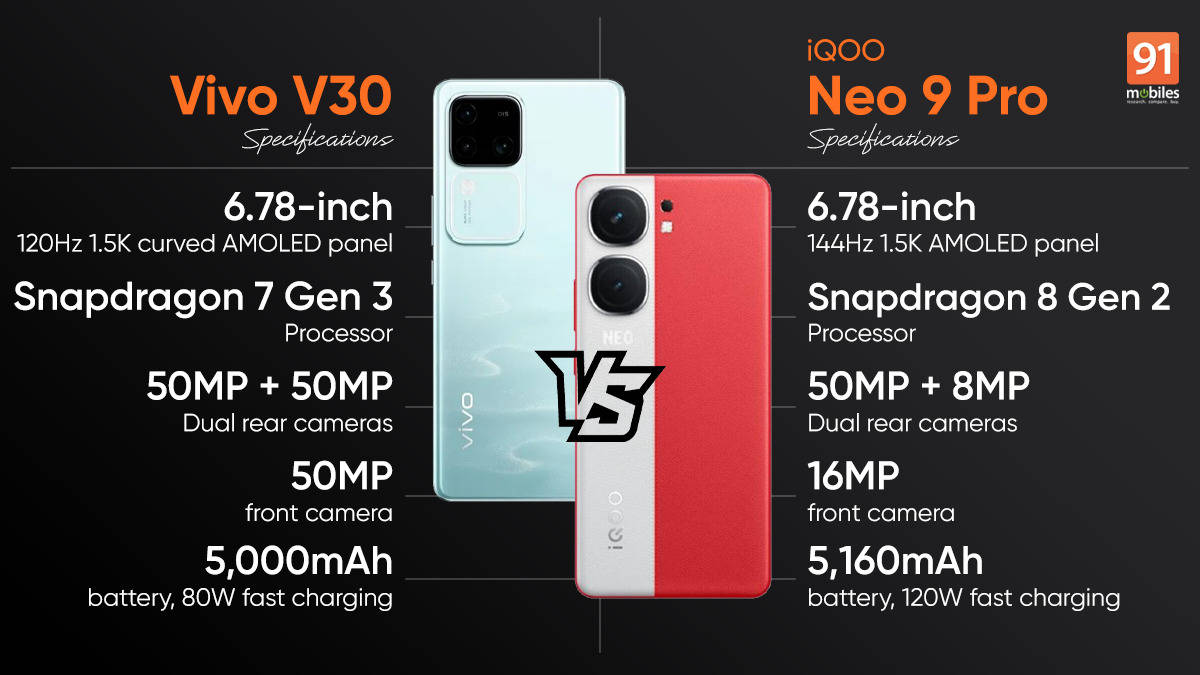
The Vivo V30 series has launched in India and comes as a successor to the Vivo V29 series smartphones. The V30 series marks the introduction of Zeiss optics, which used to be an X series exclusive, and provides a significant boost to the already potent 50MP camera system across the board of the V30 series. We will be comparing the Vivo V30 with the iQOO Neo 9 Pro to see what sets them apart.
Table of Contents
Vivo V30 vs iQOO Neo 9 Pro: key specs
| Smartphone | Vivo V30 | iQOO Neo 9 Pro |
| Display | 6.78-inch 120Hz 1.5K curved AMOLED panel | 6.78-inch 144Hz 1.5K AMOLED panel |
| Processor | Snapdragon 7 Gen 3 SoC | Snapdragon 8 Gen 2 SoC |
| RAM, storage | Up to 12GB RAM and 256GB ROM | Up to 12GB RAM and 256GB ROM |
| Cameras | 50MP+50MP rear camera, 50MP selfie camera | 50MP+8MP rear camera, 16MP selfie camera |
| Battery, charging | 5,000mAh, 80W charging | 5,160mAh, 120W charging |
Vivo V30 vs iQOO Neo 9 Pro: price
| Vivo V30 | iQOO Neo 9 Pro |
| 8GB + 128GB: Rs 33,999 | 8GB + 128GB: Rs 35,999 |
| 8GB + 256GB: Rs 35,999 | 8GB + 256GB: Rs 37,999 |
| 12GB + 256GB: Rs 37,999 | 12GB + 256GB: Rs 39,999 |
Vivo V30 vs iQOO Neo 9 Pro: design
When it comes to design, both smartphones are wildly different from each other. The Vivo V30 is quite slim, at just 7.45mm thin, and comes with a curved display and edges, which give it a comfortable in hand feel. The non-marble finish variants offer a satin-like finish that does a good job of hiding fingerprints and smudges, while the marble finish looks stunning. The camera deco is still placed similarly to the V29, with some design changes to the aura light, which is now a rectangular LED ring rather than a circular ring. The device comes with an IP54 rating and is available in Peacock Green, Andaman Blue (marble finish), and Classic Black colours.
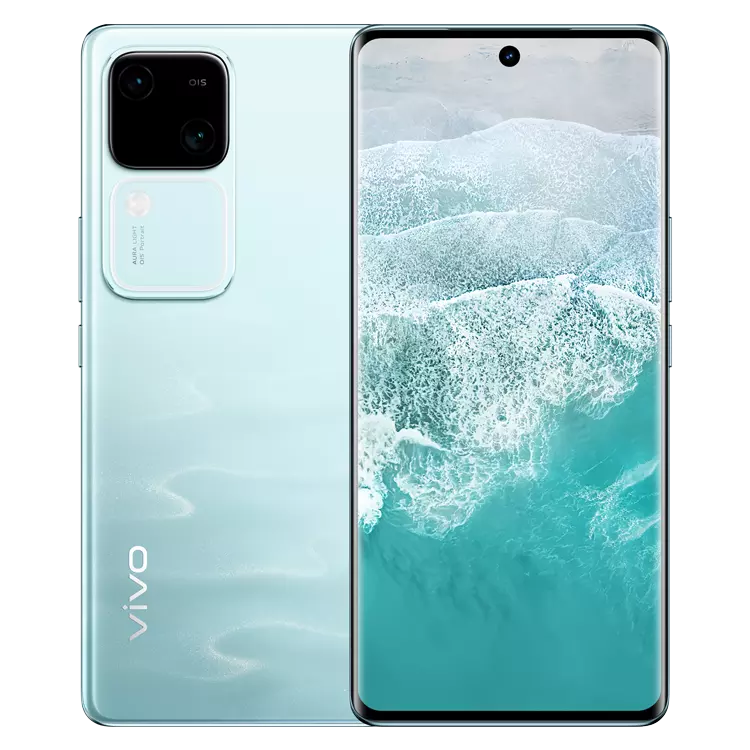
The iQOO Neo 9 Pro comes in a new design that differs a lot from its predecessor, the Neo 7 Pro. Gone is the boxy camera deco, replaced with two large camera cutouts, and the rear back is now made of simple plastic with a satin-like finish for the black colour (Conqueror Black) variant. This finish helps minimise fingerprints and smudges. The Fiery-Red variant, on the other hand, comes with a vegan leather finish that is quite eye-catching. The black variant is thinner at 7.99mm, while the Fiery-Red measures 8.34mm in thickness. The device, unfortunately, does not come with a headphone jack. The smartphone features an IP54 rating for water and dust resistance.
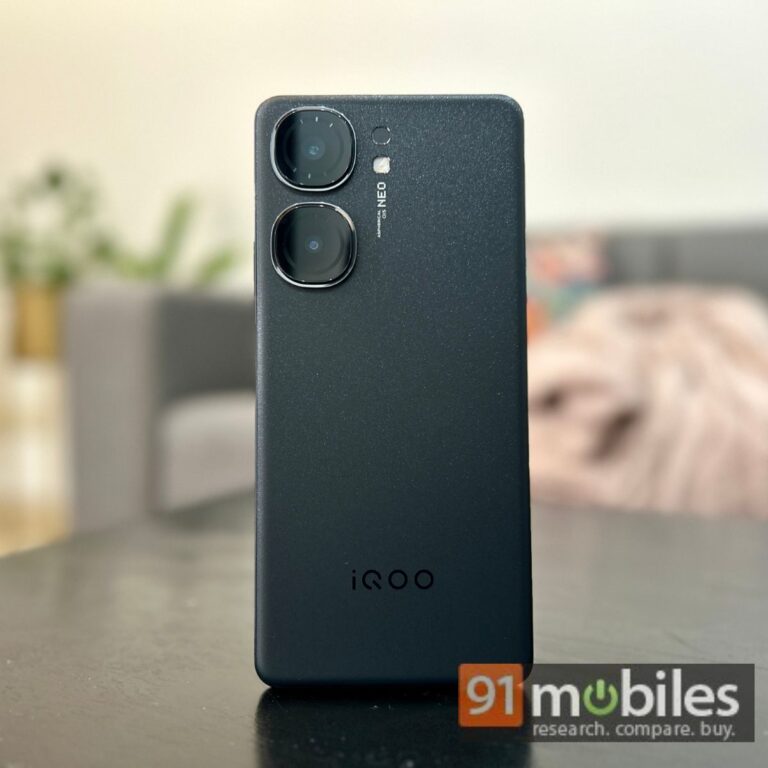
Vivo V30 vs iQOO Neo 9 Pro: display
Both smartphones feature a 6.78-inch AMOLED panel with a 1.5K resolution (2,800 x 1,260p). The Vivo V30 features a curved AMOLED panel, however, with a peak brightness level of 2,800nits, and a 120Hz refresh rate. In comparison, the iQOO Neo 9 Pro features a flat display with 3,000nits of peak brightness and a 144Hz peak refresh rate (during gaming). Both smartphones also come with HDR10+ support for HD content streaming on OTT platforms.
Conclusion: The iQOO Neo 9 Pro offers a better display compared to the Vivo V30, with a higher refresh rate and peak brightness level. The difference is not very significant, however, and would not be readily apparent in day-to-day usage.
Vivo V30 vs iQOO Neo 9 Pro: cameras
When it comes to photography, the Vivo V series has always been known to boast one of the best camera setups for the price segment. This holds true for the V30 as well, which comes with a 50MP primary camera with OIS and EIS support and a 50MP ultra-wide lens. At the front, there’s a punch-hole cutout that houses the 50MP selfie camera.
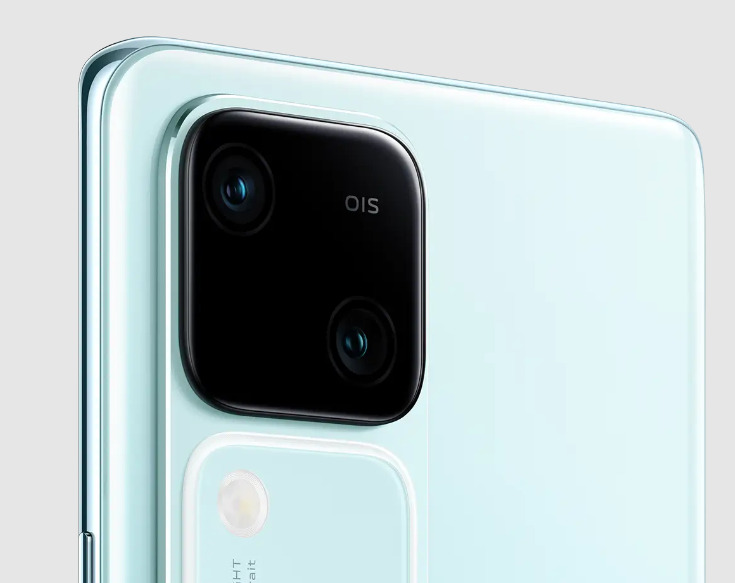
The iQOO Neo 9 Pro also features a decent camera setup for a performance-centric smartphone and comes with a 50MP Sony IMX920 primary lens paired with an 8MP ultra-wide lens. For selfies, it comes with a 16MP lens at the front.
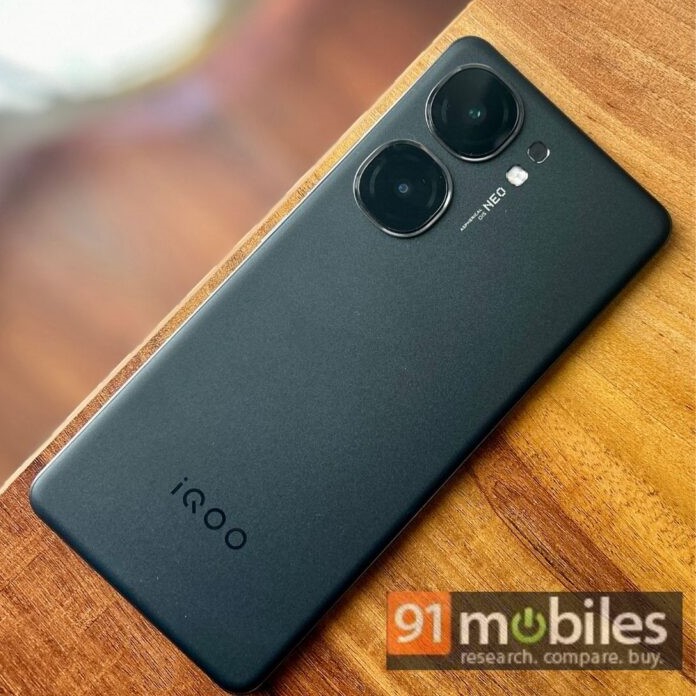
Conclusion: The Vivo V30 is clearly superior to the Neo 9 Pro when it comes to cameras. It features a higher-resolution ultra-wide lens and a better selfie camera.
Vivo V30 vs iQOO Neo 9 Pro: performance and software
The Qualcomm Snapdragon 7 Gen 3 SoC powers the Vivo V30, while the Snapdragon 8 Gen 2 SoC powers the iQOO Neo 9 Pro. Both smartphones come with up to 12GB of RAM and 256GB storage support. In terms of software, both devices operate on FuntouchOS 14 based on Android 14 out of the box.
Conclusion: The iQOO Neo 9 Pro stands out as the top-performing smartphone under Rs 40,000, largely due to the powerhouse 2023 flagship chipset it runs on. On the other hand, the Vivo V30, although delivering respectable performance, doesn’t quite match up to the performance-centric focus of the iQOO Neo 9 Pro. In terms of software, both phones boot the same OS and provide a comparable user experience.
Vivo V30 vs iQOO Neo 9 Pro: battery
A 5,000mAh battery with 80W fast charging powers the Vivo V30, while a 5,160mAh battery with 120W fast charging fuels the iQOO Neo 9 Pro.
Conclusion: The battery output on both devices is quite close, with iQOO in a slight lead thanks to its higher rated battery cell. When it comes to charging speed, the iQOO Neo 9 Pro is the better choice, with a much more potent fast charging capacity. It is worth noting, however, that the Vivo V30’s 80W charging is quite fast as well, and the difference in day-to-day usage is not too far apart.




















